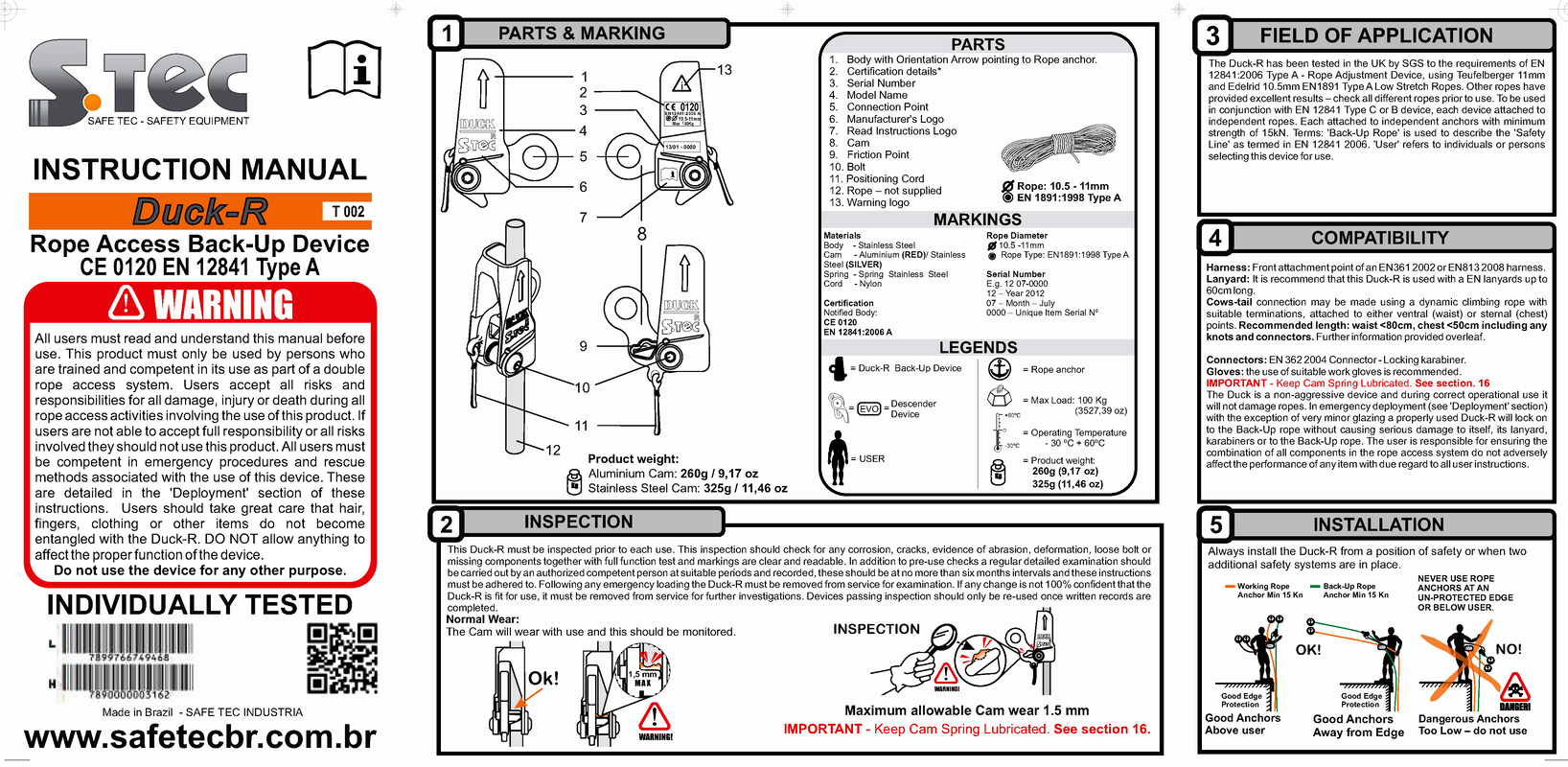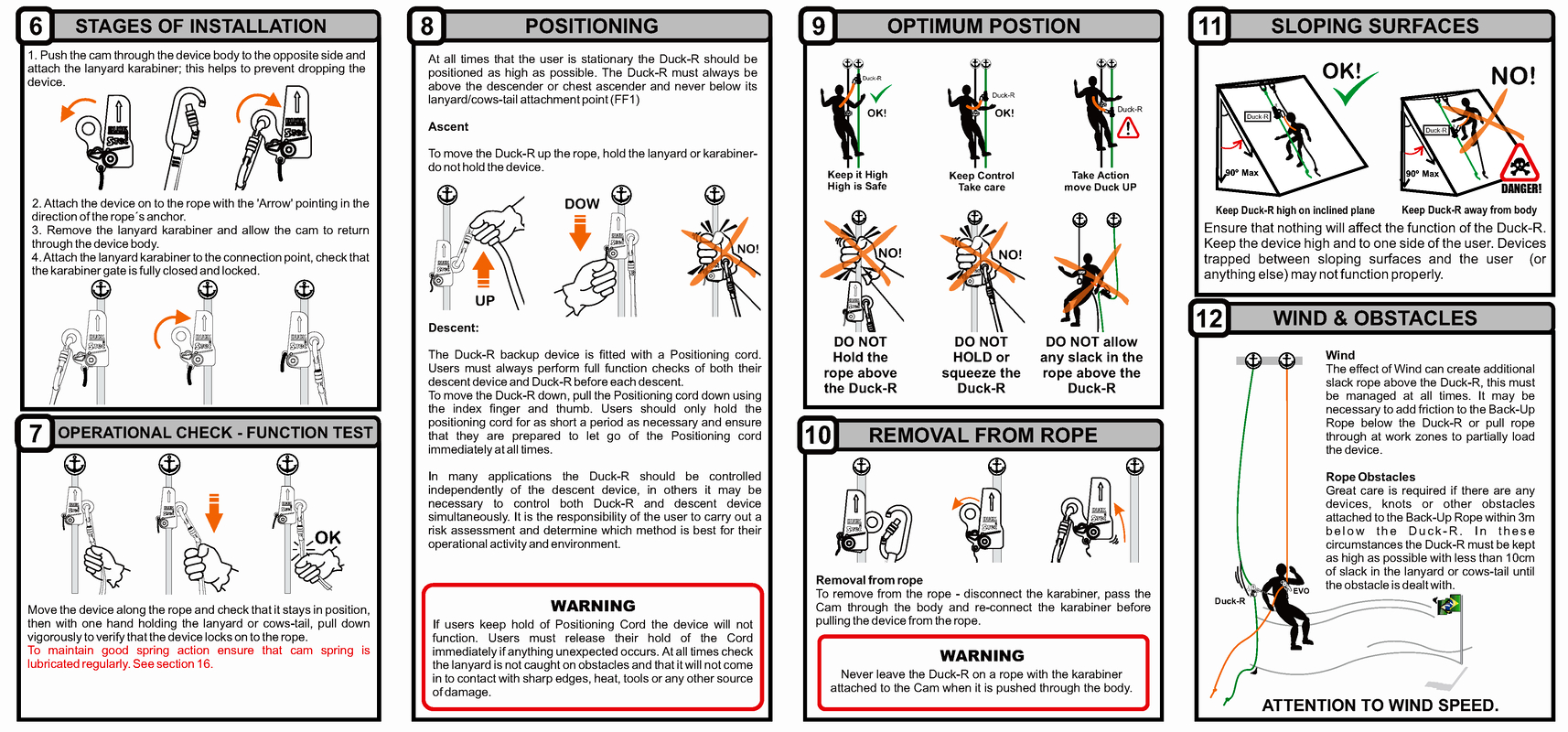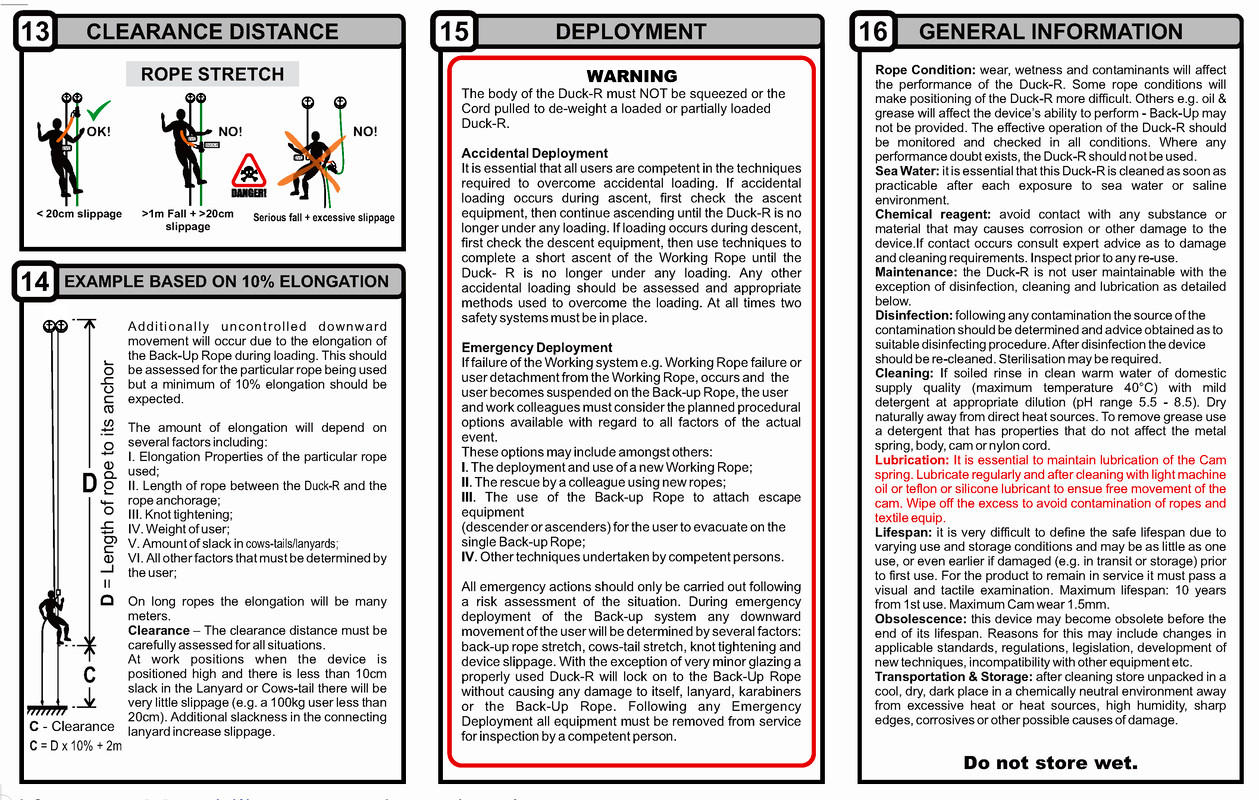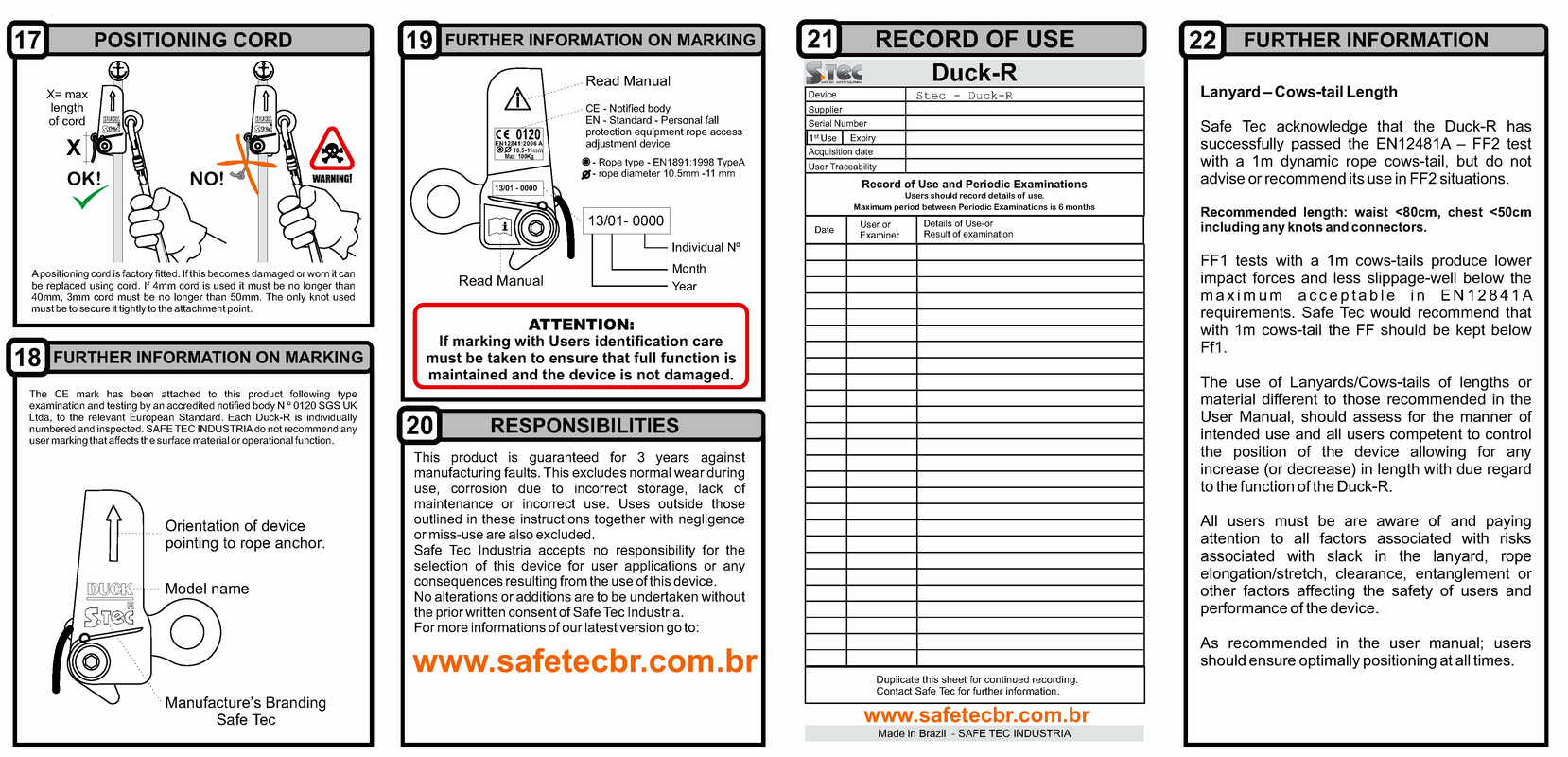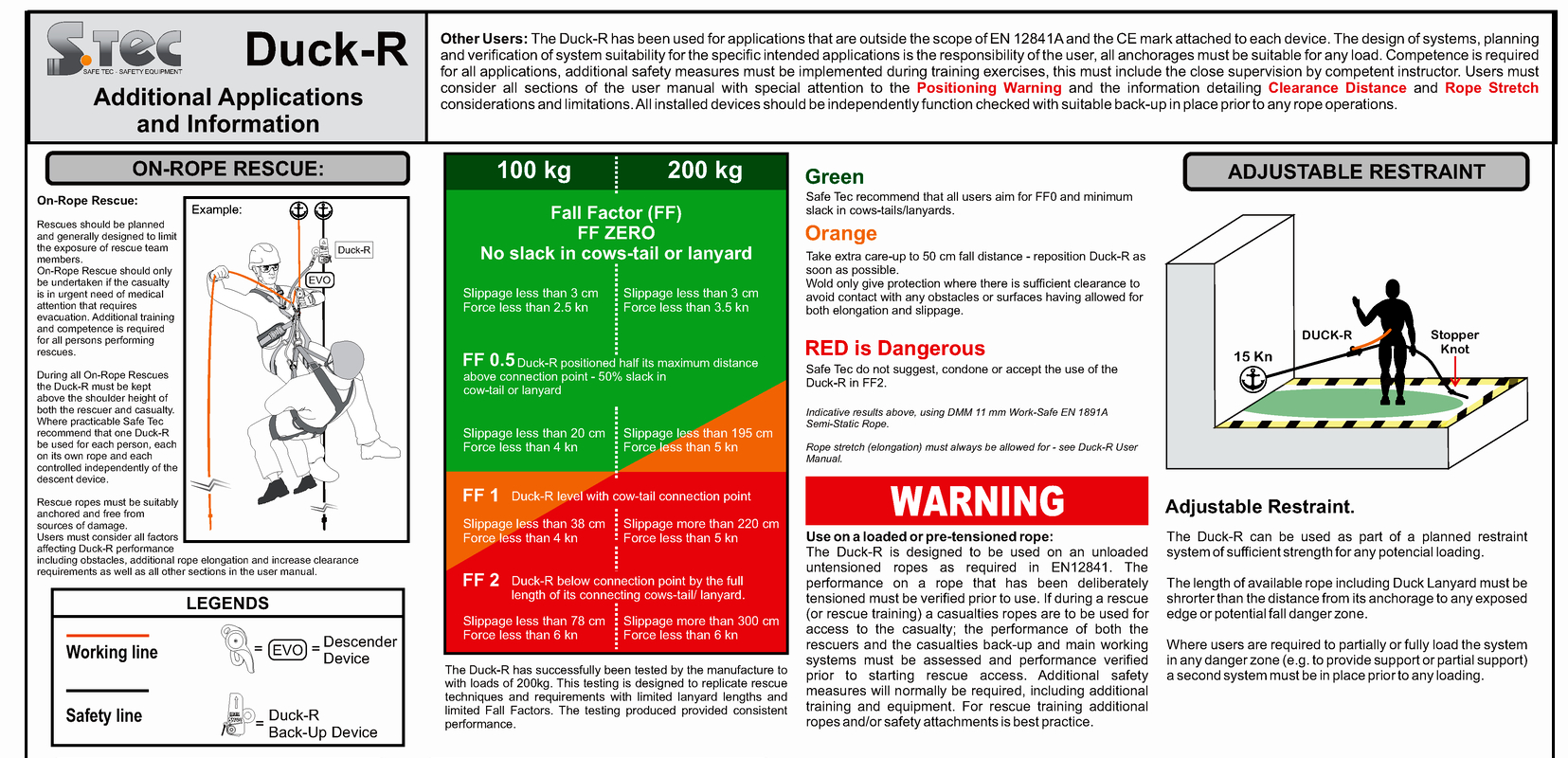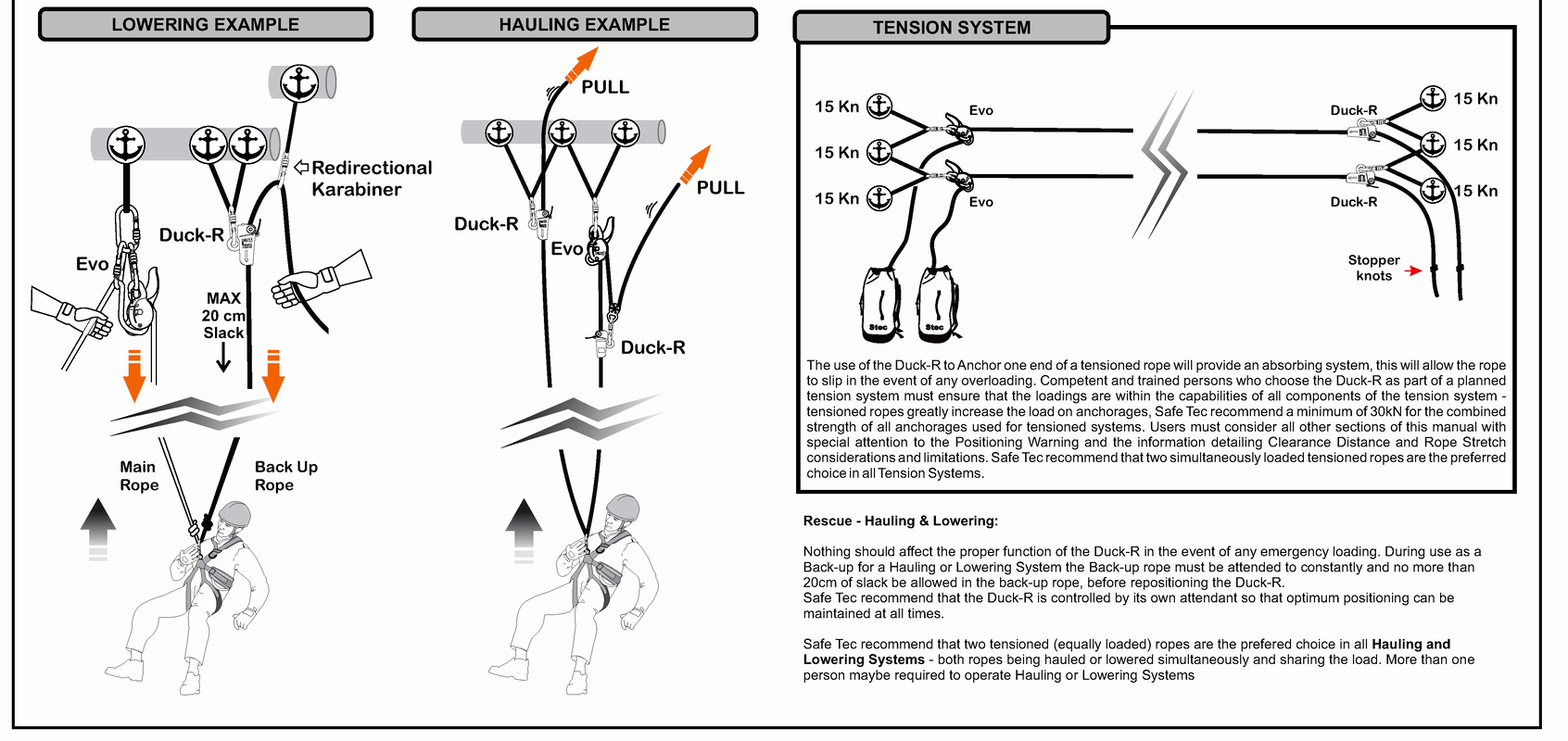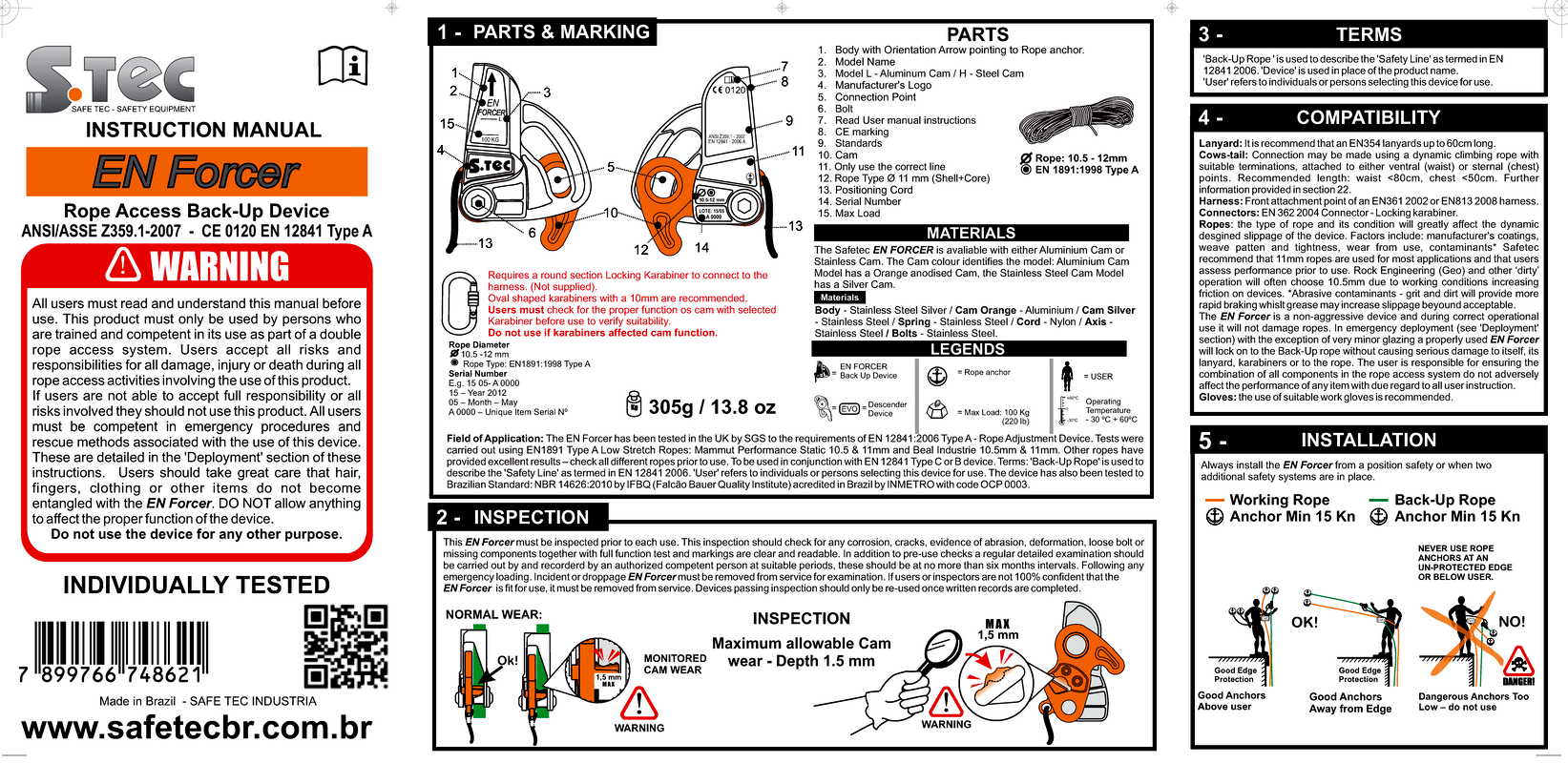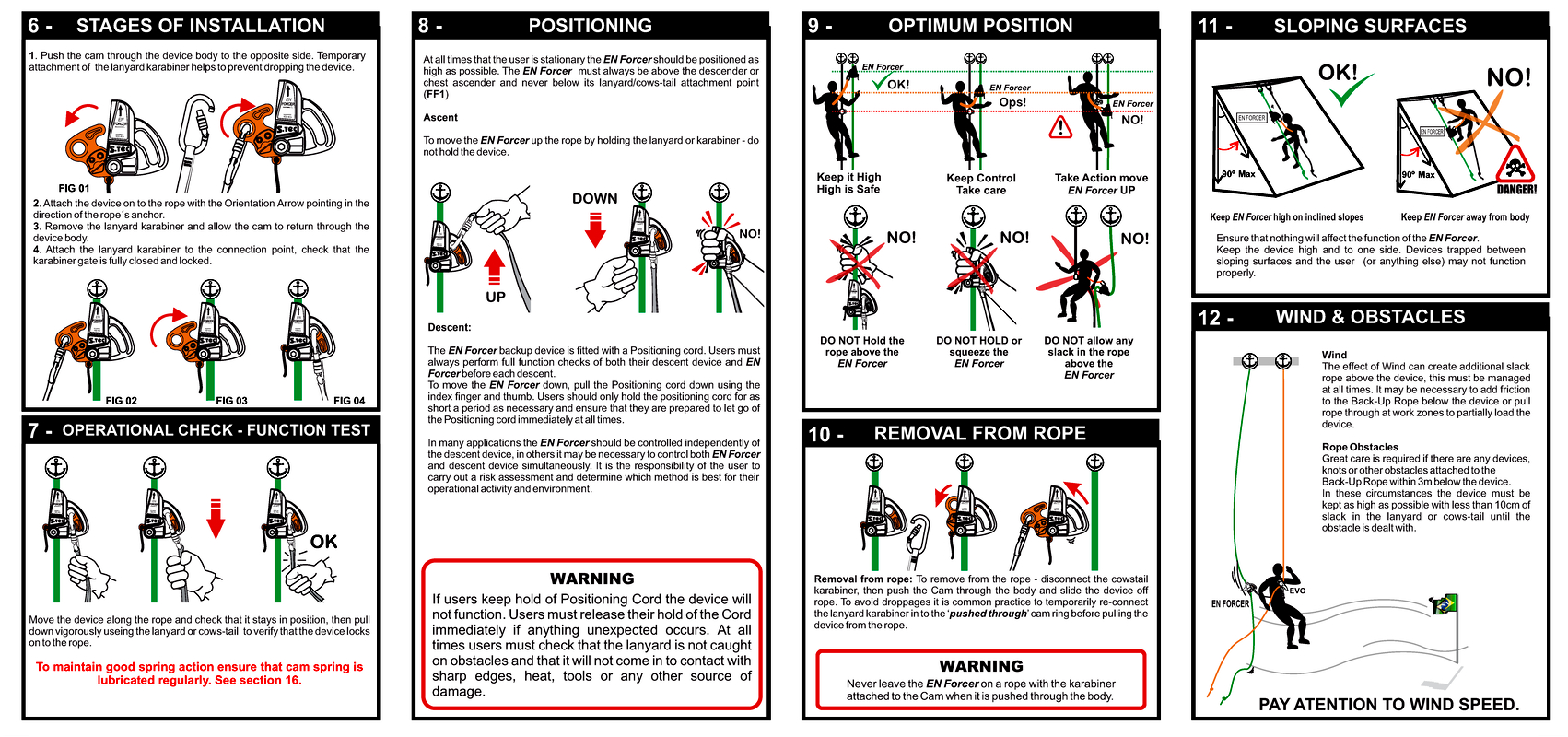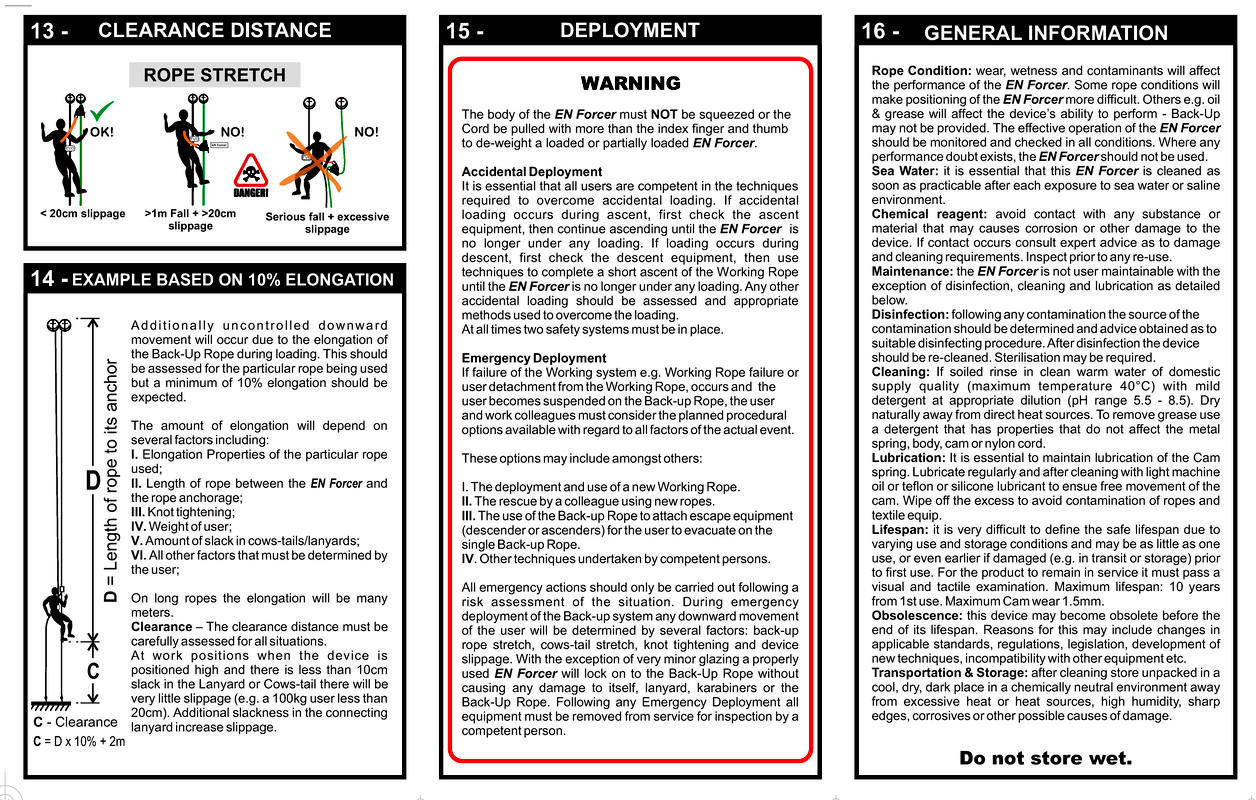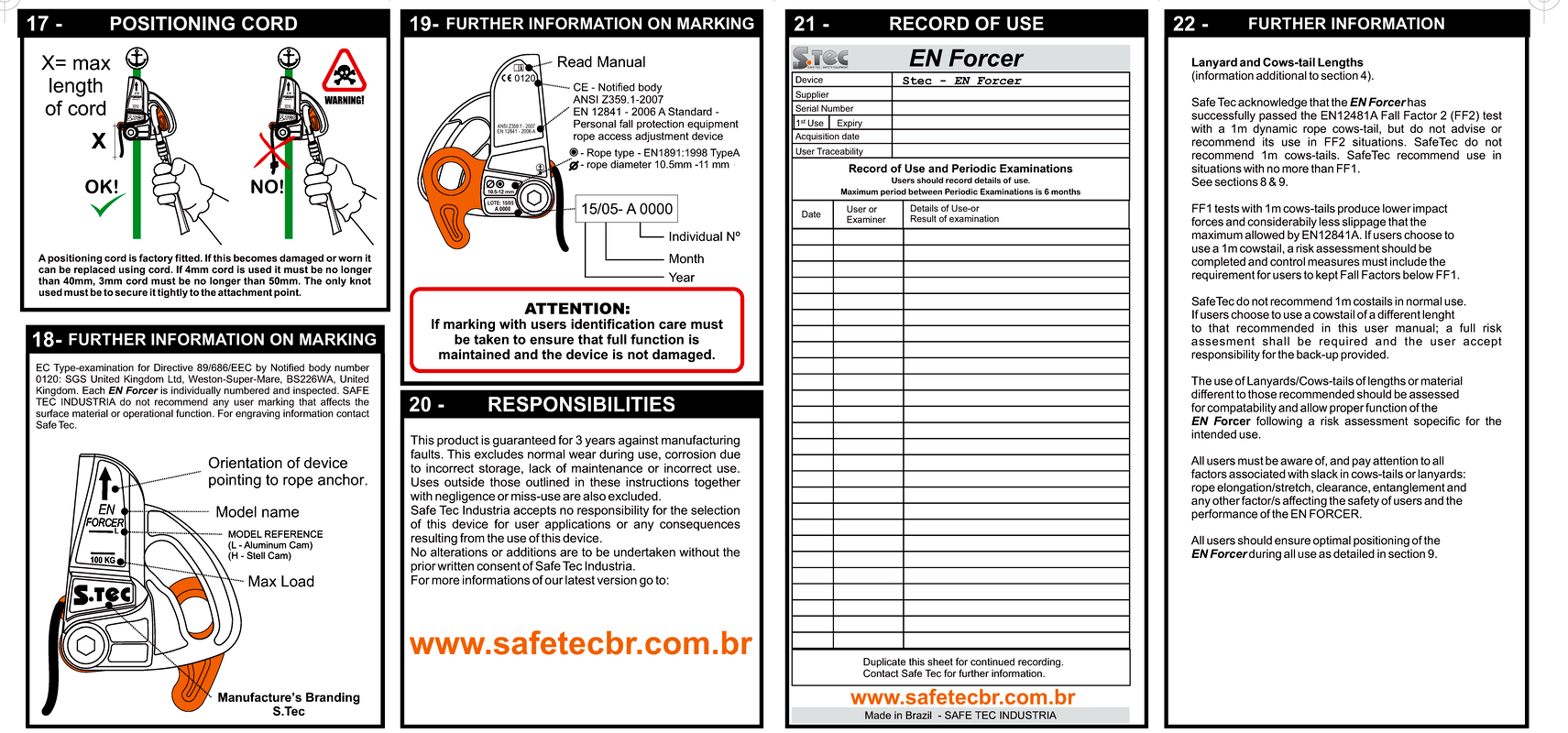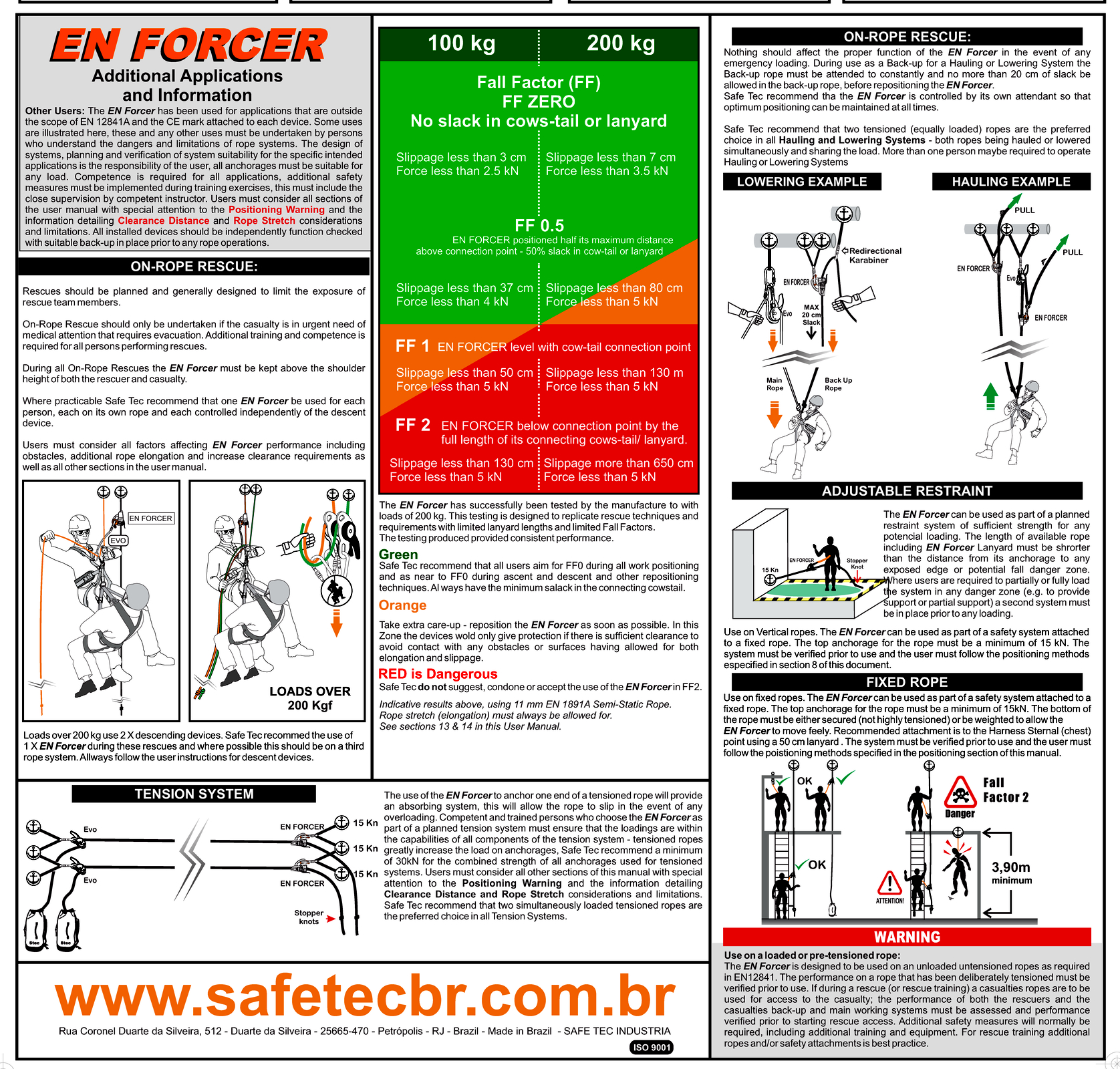Overview
[ Top
| Duck–R, Version B
| Duck–R, Version C
| EN Forcer H
| EN Forcer L
| Return to Rope Grabs
]
Duck–R, Version A
(#1808, 2638)
Technical Details
I acquired a Safe-Tec Duck-R, Version A from Altius Technical Services in 2013. I acquired another in 2017 as part of Bob Thrun’s collection.
Version A is 72 mm. tall, 41 mm. wide, 97 mm. deep, and weighs 249 g. The Duck-R uses an aluminum frame with a rectangular cross section. The frame wraps around the static rope. A forged aluminum lever is mounted in the frame, and
can be pulled through the back of the frame to allow rigging the
rope. The lever is spring loaded so it will automatically return
to the operating position. A projection on the rope side of the lever presses the rope against the
frame. A projection on the other side of the lever moves in a slot in the frame, limiting the lever’s travel. There is a small hole in the back of the lever that one
can attach a small cord to to allow remotely releasing the device.
The front is forged with a hollow up-pointing arrow, "DUCK," and "S.tec." It is also stamped with the letter "R." The rear has a forged danger symbol (exclamation point inside a triangle). It is etched with "CE 0120," "EN 12841:2006A," "•Ø 10,5-11mm," "Max 100kg," "13/08-A0027," and a book-with-an-"i" icon.
The Duck-R uses the same operating principle as Type 2 Lever Cam Ascenders like the Petzl Shunt. Unlike the Shunt, the Duck-R only works on single ropes.
|
 |
Warning:
Tests reported by the the US Bureau of Reclamation showed that
the Duck-R does not always engage
It sometimes allows the user to drop the full length of the safety rope.
(Shaun Reed, Drop Testing of Rope Access Backup Devices, also see www.usbr.gov/rope/) |
 |
|
[ Top
| Duck–R, Version A
| Duck–R, Version C
| EN Forcer H
| EN Forcer L
| Return to Rope Grabs
]
Duck–R, Version B
(#3834, 3836)
Technical Details
I acquired two Safe-Tec Duck-R Version Bs in 2023, one from David Garcia and one from Thomas Gaubert.
Version B is 72 mm. tall, 41 mm. wide, 97 mm. deep, and weighs 250 g. The Duck-R uses an aluminum frame with a rectangular cross section. The frame wraps around the static rope. A forged aluminum lever is mounted in the frame, and
can be pulled through the back of the frame to allow rigging the
rope. The lever is spring loaded so it will automatically return
to the operating position. A projection on the rope side of the lever presses the rope against the
frame. A projection on the other side of the lever moves in a slot in the frame, limiting the lever’s travel. There is a small hole in the back of the lever that one
can attach a small cord to to allow remotely releasing the device.
The front is forged with a hollow up-pointing arrow, "DUCK," and "S.tec." It is also etched with the letter "R." The rear has an etched danger symbol (exclamation point inside a triangle), "CE 0120" ("CE 0598" on the one from Tom), "EN 12841:2006A," "•Ø 10,5-11mm," "Max 100kg," "18/04 - A 0216" ("21/11-A0078" on the one from Tom) and a book-with-an-"i" icon. The screw heads are stamped with "R" and "A2" ("TONG" and "A2-070" on the one from Tom)
Version B is functionally identical to Version A.
|
 |
Warning:
Tests reported by the the US Bureau of Reclamation showed that
the Duck-R does not always engage
It sometimes allows the user to drop the full length of the safety rope.
(Shaun Reed, Drop Testing of Rope Access Backup Devices, also see www.usbr.gov/rope/) |
 |
|
[ Top
| Duck–R, Version A
| Duck–R, Version B
| EN Forcer H
| EN Forcer L
| Return to Rope Grabs
]
Duck–R, Version C
(#3835)
Technical Details
I acquired my Safe-Tec Duck-R Version C from Thomas Gaubert in 2023.
Version C is 73 mm. tall, 41 mm. wide, 97 mm. deep, and weighs 258 g. The Duck-R uses an aluminum frame with a rectangular cross section. The frame wraps around the static rope. A forged aluminum lever is mounted in the frame, and
can be pulled through the back of the frame to allow rigging the
rope. The lever is spring loaded so it will automatically return
to the operating position. A projection on the rope side of the lever presses the rope against the
frame. A projection on the other side of the lever moves in a slot in the frame, limiting the lever’s travel. There is a small hole in the back of the lever that one
can attach a small cord to to allow remotely releasing the device.
The front is forged with an up-pointing arrow, "DUCK•R," and "S.tec." The rear has an etched danger symbol (exclamation point inside a triangle), "CE 0598," "EN 12841:2006A," "•Ø 10,5-11mm," "Max 100kg," "2206A-1177," and a book-with-an-"i" icon. The screw heads are stamped with "TONG" and "A2-070."
Version B is functionally identical to Version A.
|
 |
Warning:
Tests reported by the the US Bureau of Reclamation showed that
the Duck-R does not always engage
It sometimes allows the user to drop the full length of the safety rope.
(Shaun Reed, Drop Testing of Rope Access Backup Devices, also see www.usbr.gov/rope/) |
 |
|
[ Top
| Duck–R, Version A
| Duck–R, Version B
| Duck–R, Version C
| EN Forcer L
| Return to Rope Grabs
]
EN Forcer H
(#3824)
Technical Details
I acquired this Safe-Tec EN Forcer H from Joshua Woodis in 2022.
My Safe-Tec EN Forcer H is 76 mm. tall, 41 mm. wide, 86 mm. deep, and weighs 390 g. The EN Forcer H uses a forged stainless steel frame with a rectangular cross section. The frame wraps around the static rope. A forged stainless steel lever is mounted in the frame, and
can be pulled through the back of the frame to allow rigging the
rope. The lever is spring loaded so it will automatically return
to the operating position. A projection on the rope side of the lever presses the rope against the
frame. A projection on the other side of the lever moves in a slot in the frame, limiting the lever’s travel. There is a small hole in the back of the lever that one
can attach a small cord to to allow remotely releasing the device.
The front is etched with an up-pointing arrow, "EN," "FORCER," a horizontal line followed by "H," "CA 36677," "CA 36678," another horizontal line, "100 KG," and "S.tec."" The rear is etched with a book-with-an-"I" icon, "CE 0120," "Segurenca," an IEBQ FALÃO BAUER logo with "OCP 0003" underneath, an INMETRO logo, "Ministério do Trabalho e Emprego," "ANSI z359.1-2007," "EN 12841-2006A," "NBR 14626:2010," "TRAVA QUEDAS DESLIZANTE USAR SOMENTE EM LINHA DE ANCORAGEM CORRETA," a icon of an anchor inside a circle with two iines beneath, "•Ø 10.5–12 mm," "LOTE:15/10," and "A0349."
Safe-Tec products are made in Brazil. The EN Forcer H was introduced in 2015. Its stainless steel construction makes it heavier than the Duck–R, Version A, but the EN Forcer H is far more wear-resistant.
The 100 kg. weight limit is somewhat surprising, but may simply reflect the extent of EN Forcer H testing.
[ Top
| Duck–R, Version A
| Duck–R, Version B
| Duck–R, Version C
| EN Forcer H
| Return to Rope Grabs
]
EN Forcer L
(#3828)
Technical Details
I acquired this Safe-Tec EN Forcer L from Elaine Gomez in 2023.
My Safe-Tec EN Forcer L is 76 mm. tall, 42 mm. wide, 86 mm. deep, and weighs 304 g. The EN Forcer L uses a forged stainless steel frame with a rectangular cross section. The frame wraps around the static rope. A forged and anodized aluminum lever is mounted in the frame, and
can be pulled through the back of the frame to allow rigging the
rope. The lever is spring loaded so it will automatically return
to the operating position. A projection on the rope side of the lever presses the rope against the
frame. A projection on the other side of the lever moves in a slot in the frame, limiting the lever’s travel. There is a small hole in the back of the lever that one
can attach a small cord to to allow remotely releasing the device.
The front is etched with an up-pointing arrow, "EN," "FORCER," a horizontal line followed by "L," "CA 36677," "CA 36678," another horizontal line, "100 KG," and "S.tec."" The rear is etched with a book-with-an-"I" icon, "CE 0598," "Segurenca," an IEBQ FALÃO BAUER logo with "OCP 0003" underneath, an INMETRO logo, "Ministério do Trabalho e Emprego," "ANSI z359.1-2007," "EN 12841-2006A," "NBR 14626:2010," "TRAVA QUEDAS DESLIZANTE USAR SOMENTE EM LINHA DE ANCORAGEM CORRETA," a icon of an anchor inside a circle with two iines beneath, "•Ø 10.5–12 mm," "LOTE:21/04," and "A0508." A previous owner engraved "A185973" on the front side.
The aluminum lever makes the EN Forcer L 22% lighter than the EN Forcer H.
The 100 kg. weight limit is somewhat surprising, but may simply reflect the extent of EN Forcer L testing.
[ Top
| Duck–R, Version A
| Duck–R, Version B
| Duck–R, Version C
| EN Forcer H
| EN Forcer L
]



